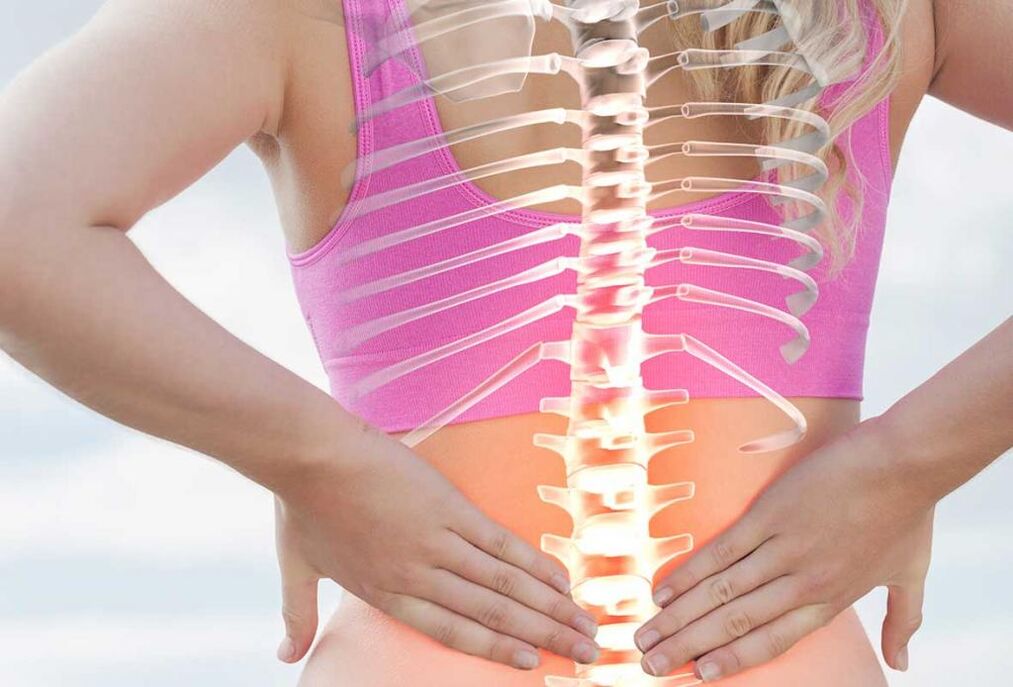The lumbar spine unites the thoracic region with the sacrum, is characterized by great mobility and has 5 vertebrae. Regardless of one’s lifestyle, this part of the ridge is subjected to a relatively heavy load on a daily basis. For this reason, lumbar osteochondrosis is considered a very common pathology in which the disc between the vertebrae is deformed. Without proper treatment, dangerous complications can develop.

Common symptoms of lumbar spine osteochondrosis
The first and main sign of the formation of this disease is persistent acute pain in the lumbar region. The pain may come on suddenly. The back loses flexibility, making it difficult for a person to do rounds or tilt. In certain situations, the pain can spread to the lower legs or buttocks.
The main symptoms of the following diseases are distinguished:
- pain increases with little physical activity, with coughing or sneezing;
- impaired movement of the lumbar zone after prolonged stay in one position;
- constant tension of the back muscles;
- backache;
- tingling and tingling sensation, chills in the lower part of the legs;
- sensory disturbances in the thighs, back, and sometimes in the legs;
- disturbed sweating;
- leg artery spasm, pulse may be lost;
- in painful areas, flaking, as well as dryness of the skin, loss of sensitivity is possible.
Often, patients suffering from lumbar osteochondrosis have general irritation and fatigue. It is difficult for a person to find a comfortable position to rest in bed, and as a result, the patient’s sleep is disturbed. In addition, with this pathology, there may be a violation of the function of the organs of the genitourinary system.
Medical treatment of lumbar osteochondrosis
Treatment of the disease with the help of prescribed drugs:
- to relieve pain;
- to relieve tight muscles;
- to relieve inflammation at the nerve endings;
- to increase metabolism in tissues;
- to restore damaged cartilage tissue;
- to normalize blood flow.
All of the above tasks are completed by an individual treatment regimen properly selected by the physician.
For the treatment of this disease, the following drugs are prescribed in tablet form:
- to relieve pain, an analgesic is used that has a quick effect - Analgin. It should be noted that in the acute course of osteochondrosis, these drugs are characterized by short-term effects;
- to relieve pain and reduce inflammation, use non-steroidal anti-inflammatory drugs;
- chondroprotectors are used to protect cartilage tissue from further destruction;
- also, to improve the patient's condition, it is recommended to take in the form of vitamin tablets, immunomodulators.
Drug therapy involves the use of creams, ointments and gels. All drugs for topical use can be divided into the following groups:
- drugs containing analgesics or non-steroidal anti-inflammatory drugs. This group has analgesic effects;
- combination drugs. These drugs contribute to tissue repair, have anti-inflammatory effects, as well as can be absorbed. They are characterized by analgesic and thrombolytic effects;
- drugs that have analgesic, as well as local irritating effects. They dilate blood vessels, increase blood flow to the affected area, normalize metabolic processes;
- chondroprotectors in the form of topical agents;
- homeopathic medicine is characterized by anti-inflammatory, anti-edematous effect. They have analgesic and restorative effects.
In addition, massage balms, which have a solution and anti-inflammatory effect, show a good effect. These drugs are characterized by analgesic effect.
We should not forget about such drug therapy methods in the treatment of lumbar osteochondrosis as injections. Injections help in a short time to enter the drug into the body. Spinal blockade is considered effective - the introduction of an anesthetic in place with the affected nerve root. With this method, rapid pain relief is achieved.
Restrictions are prescribed to relieve urgent pain, reduce cramps, tension and tension in the muscles, and have a positive effect on the inflammatory process.
In addition to restriction, with lumbar osteochondrosis, regular injections for intramuscular or intravenous administration are also prescribed.
To relieve psychoneurological pathology, sedatives, anticonvulsants, and antidepressants may be used.
With manifestations of radiculopathy, doctors prescribe diuretics, and with paralysis - take anticholinesterase drugs.
The pharmaceutical industry produces a large number of drugs to fight this disease, the reception of which can only be prescribed by a doctor.
Treatment with physiotherapy for lumbar osteochondrosis
For the effectiveness of therapy for lumbar osteochondrosis, drug treatment should be supplemented with physiotherapy:
- electrotherapy is considered one of the most common methods of relieving pain in inflamed muscles. This procedure uses low power current. Course of treatment - 6 procedures;
- laser therapy allows you to remove inflammation, improve microcirculation. The affected area is influenced by electromagnetic waves and quantum particles. Highly penetrating into tissues, infrared radiation stimulates metabolic processes, activates the recovery of cartilage tissue;
- detensor therapy. The essence of the method is the extension of the spine under its own weight. Special mattresses are used. This method allows you to normalize muscle tone;
- shock wave therapy can relieve pain and relieve swelling. The essence of the method is the effect of a constant or variable magnetic field of different frequencies;
- ultrasound therapy helps relieve inflammation and pain. Ultrasonic waves, acting in a direction on the affected area, activate metabolic processes.
In addition, ultraviolet irradiation and vibration therapy on vibration massage tools can be used.
Lumbar osteochondrosis is considered a relatively common disease. With improper treatment, pathology can lead to dangerous complications. Complex therapy of osteochondrosis usually eliminates the unpleasant manifestations of the disease and returns the patient to daily life.



















